Behind the Scenes of ‘CSI: Vegas.’
MadMicrobe explains how they use Maxon One and other tools to create detailed medical and science animations for the popular series.
Forensic investigators in the CBS series “CSI: Vegas” use all manner of cutting-edge techniques to solve crimes that can often be mysterious and gruesome. One of the best parts of the show are the detailed reenactments that pop on screen when the investigators talk through their ideas about what happened to victims.
Though the show is fictional, those animated reenactments need to be fairly scientifically accurate to reflect what a real forensic crime lab could be capable of without veering into sci-fi territory. That’s why CoSA VFX, who has long worked on the series, brought on award-winning medical and science animation studio MadMicrobe.
MadMicrobe CSI:Vegas Seasons 1&2 CG Reel from MadMicrobe on Vimeo.
Using Cinema 4D, Houdini, ZBrush, Redshift, X-Particles and more, MadMicrobe created a wide variety of VFX medical/science animations for seasons 1 and 2 of “CSI: Vegas.” We talked with Joel Dubin, MadMicrobe’s cofounder and creative director, as well as MadMicrobe Senior Generalist Andy Lefton and animator Patrick Letourneau, to learn how they create such high-science CG on TV’s tight deadlines. Here’s what they told us.
Tell us how MadMicrobe got involved with “CSI: Vegas.”
Dubin: We got involved early in 2022. CoSA VFX asked us to do some work on season 1 when the show was kicking off again in Vegas. They wanted a studio with a strong science and medical understanding, as well as a flair for high-end cinematic visuals, so we tried some things for the opening shot of the first episode that involved microscopic organisms swimming in a murky bowl of water, and it worked out great.
For that, we researched and built a daphnia and an ostracod in ZBrush, as well as a parrot’s beak as viewed at the microscopic level. We storyboarded out the shot ourselves, creating some style frame look-dev, things we do for most projects. As we moved along, we began to drop a lot of the prepro work and would dive directly into blocking out animation.
Most of us here at MadMicrobe use Cinema 4D for our day-to-day CG work and find its workflow and tools like Mograph allow us to knock out shots quickly. I think we worked on eight episodes for the first season and the process of working together went very smoothly.
We delivered each shot with the level of quality and scientific accuracy they were looking for, not to mention doing so within the short timeframe you are faced with in episodic television. We made it through the season and were thrilled when they called us for season 2, which was a lot more challenging with a total of 21 episodes to push through. We weren’t needed on every one, just the ones that required a zoom into the body or forensic device to see what is going on at a cellular or molecular level.
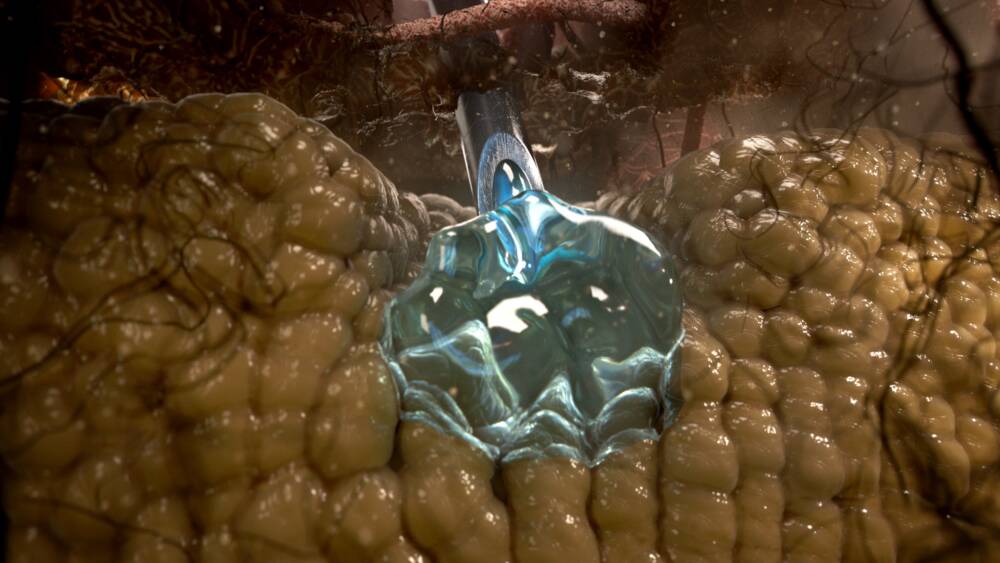
Toxin being injected into fat cells below the skin surface.
We only had a few weeks for each shot and sometimes we’d have one shot per show and sometimes we’d have three. We created a total of 28 shots for season 2 and they all had a fast turnaround, which is why we pulled Andy and Patrick onto the production team.
How did you collaborate with CoSA VFX?
Lefton: It was crazy, but a smooth kind of crazy and we quickly found a way that everything became second nature. Once we understood what the director and producer wanted, we were able to jump right into animation without storyboards or anything and nail it on the first try with some reworking. It helped that their VFX supervisor was good at explaining things, like ‘Imagine someone is punching a Jell-O mold.’
Dubin: MadMicrobe is a remote studio and I believe CoSa is too, so we would jump on a Zoom call and they would share the script and go through the shots with us. They usually gave us a few bits of reference, the rough edit, maybe a plate or a pic from the set, and a few days later we would have a very rough version of the shot knocked out for them to review. During this process our team made sure we did the necessary research to ensure each anatomical element, cell or molecule was accurately represented.
Did you feel like you had room to be creative with the shots you made?
Dubin: Definitely, there was always room for creative license. Finding ways to add that cool factor. MadMicrobe’s main task as a studio is to help our clients visualize things that can’t usually be seen with the naked eye, while also making these visuals exciting and memorable. This felt like a continuation of that work and really let us bring what we do into the Hollywood realm.
MadMicrobe CSI:Vegas Season 2 CG Process Reel from MadMicrobe on Vimeo.
Our goal was to bring in as much scientific accuracy as we could, but we also had to think about what would work best for a TV show. They wanted us to show what’s possible today in a forensic crime lab. So during a scene in the show when the actors would describe what happens in the body when a particular drug is metabolized, or when a knife penetrates the stomach and hits the aorta, we had to be sure to make those things were clear and accurate.
I was continually amazed by what the team’s enthusiasm for making each shot look as awesome as they could and by what they were able to create each week. As fast-paced and challenging as it was, it was also creatively rewarding, and I think I can speak for the team when I say that.
Say more about the knife shot you mentioned earlier.
Lefton: I worked on those shots and mainly used Cinema 4D, After Effects and Redshift. We wanted the action to be front and center, so I had to move organs around a bit to put a camera in the body. The storyline was that the investigators are doing an autopsy and talking about how the character has a laceration in his stomach.
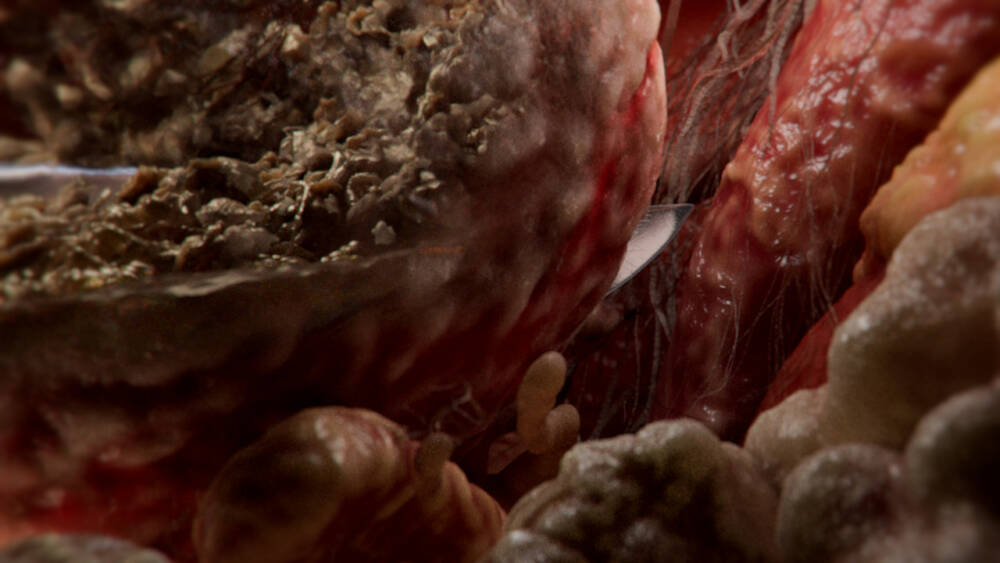
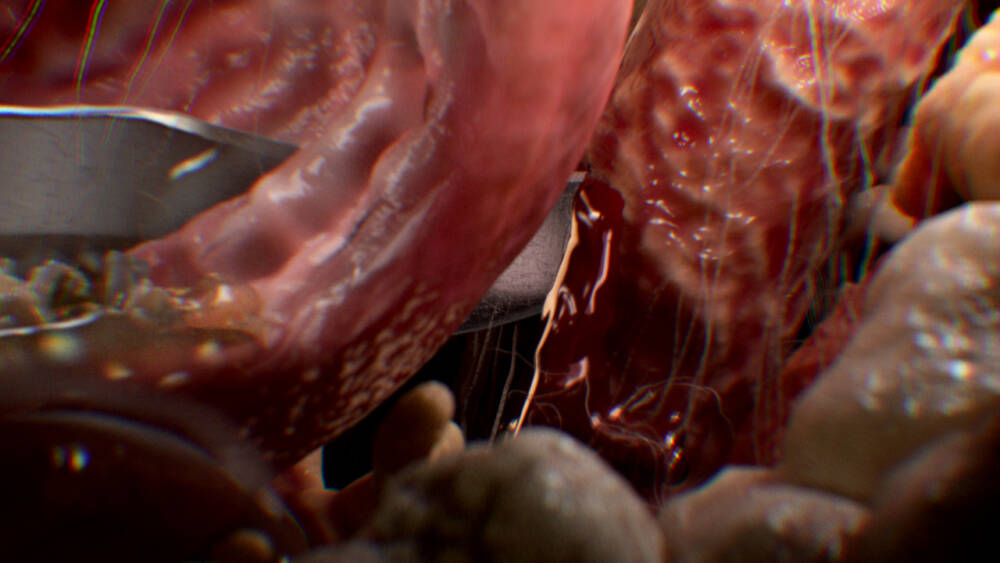
MadMicrobe shows how a knife could not reach a victim’s aorta because of pulled pork in the stomach (above) and how it could in the image below.
As they talk, the camera crashes into the body to show how the knife would have killed him if it had hit his aorta, but it couldn’t because his stomach was too full of a big meal of pulled pork. We created two shots, one showing the knife not reaching the aorta and the other showing that it did because the victim’s stomach was less full.
To make the shots more accurate, one of our team members actually chewed up food and scanned it! Then, he used ZBrush to create the meat texture. The scene was really heavy, and we used X-Particles to make stomach acid so the blade and the food could interact. I created one simulation of food tumbling and then instanced that over and over and retimed it.
That was interesting. Describe some of the other shots your team has worked on.
Lefton: All three of us did a lot of work on a season 2 episode where the victim had a skin disease and a telling marker for how they died was a basophil in the bloodstream. We created a scene where you see the cell moving through the dermal layer to
find its way to the outer layer of the skin. Figuring out that the character had a lot of basophils in a particular area of their skin helped them solve the case.

MadMicrobe used C4D and other tools to show basophils in a victim’s blood.
We also did a shot where the forensics team is talking about a water-logged body that was pulled out of the water. There was a closeup of an arm and we needed to show what was happening to the decomposing skin. CoSA sent us some reference photos of water-logged corpses, so we knew we wanted a lot of heavy gray and blue hues.
Honestly, we kind of winged everything else by doing a bit of online research and using my imagination to envision how decomposition would spread across the skin. I used Redshift and C4D and it was all animated textures, so you see the vasculature.
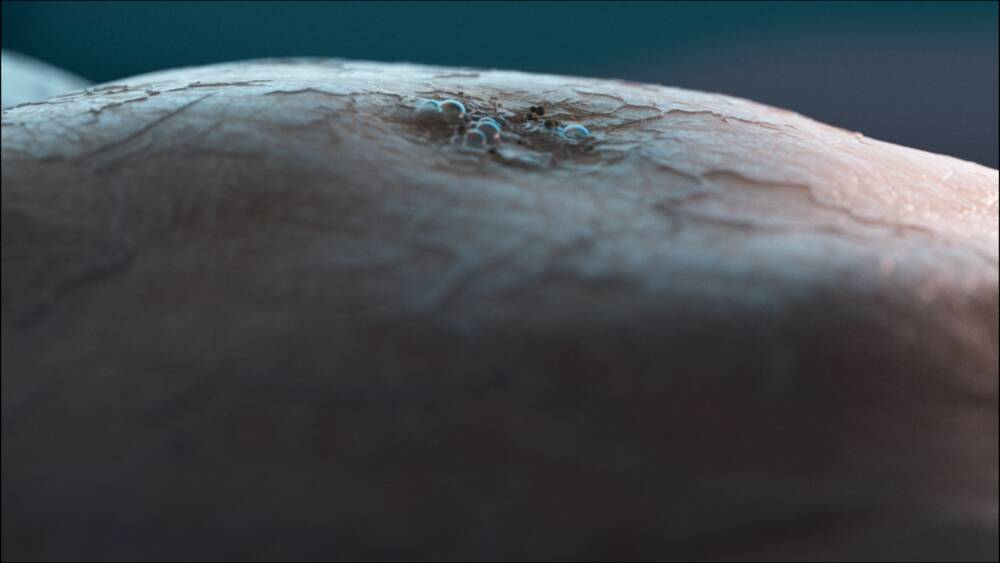
Andy Lefton’s decomposing skin shot was based on reference images, research and imagination.
Letourneau: “CSI: Vegas” relied heavily on physics simulations, including some executed in Cinema 4D, but also many using it as a hub for rendering. A great example is this shot of a bullet entering a neck (below). C4D’s jiggle deformer proved the best tool to open up a hole in the neck, and Houdini was used for most of the particle effects, brought in as Alembics.
Redshift was used throughout every shot of the series, with heavy reliance on Random Walk, which was new at the time. I’m not sure how we would have completed most of the shots in a timely fashion without it, and it proved robust, fast and incredibly flexible. For example, there is a scene where we dive into an eyeball to witness micro vessels bursting and we used Random Walk on every pixel of the 4k output, but it rendered in mere minutes per frame.
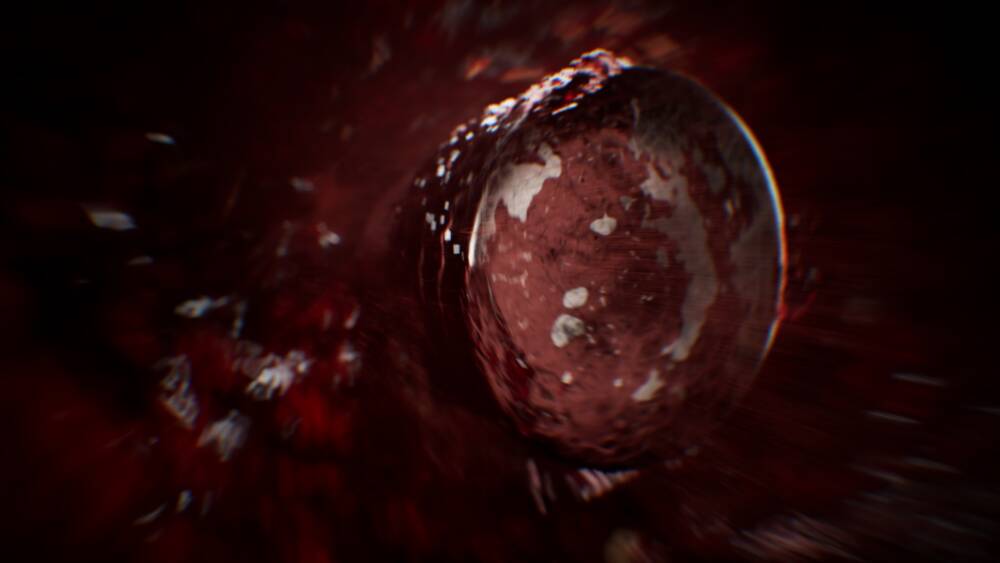
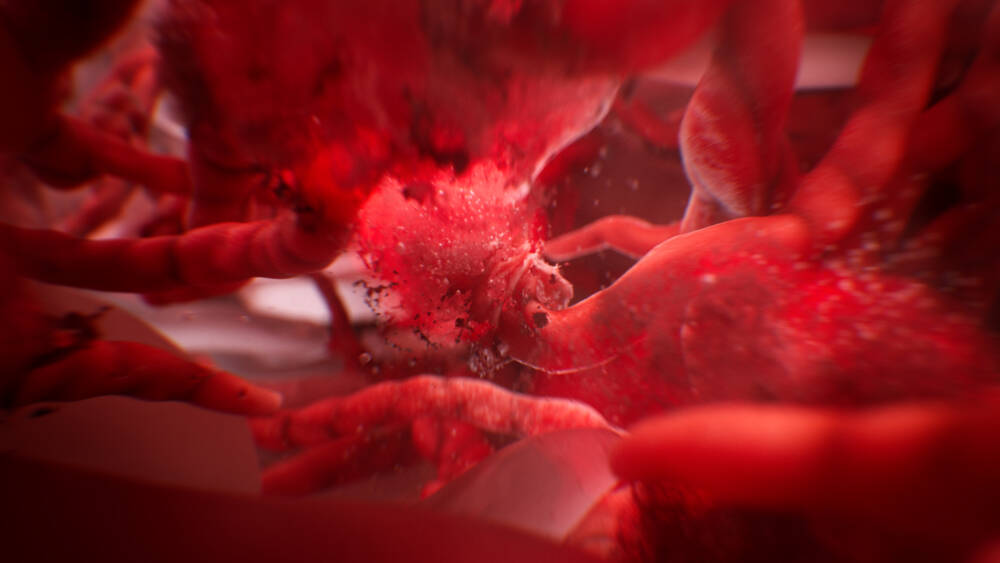
Patrick Letourneau used C4D, Houdini and Redshift for the bullet shot (above) and Houdini, ZBrush and Redshift the blood vessel shot (below).
Another shot that benefited greatly from ZBrush and Redshift was of intestines tearing apart from an explosive shockwave. We were tasked with having an explosion blast through the abdomen of a character, which was achieved by building high-resolution intestinal models with the help of ZBrush’s cloth tools for realistic folding and creasing. The cloth tools acted as a “free” uprezing step on an existing, low-res asset.

Letourneau used ZBrush for for this intestines scene.
Redshift made it easy to do everything quickly and iterate as we went. Mad Microbe is a relatively small studio, and may not have been able to turn this around as quickly, without Redshift.
Have you heard yet whether you will be working in season 3?
We were all signed up and ready to go for season 3 just as CoSA was starting production earlier this summer. We knew there was a possible writers strike brewing, so like many others in this industry, we’ll just have to wait and see what happens!
Do you see MadMicrobe doing more work like this for TV and film?
We’d love to do more TV and film work. Although our forte is medical animation, our team is versatile enough to handle any area where our skills and talents are needed. With “CSI: Vegas,” the challenges we faced technically and creatively helped our team grow and discover new tools and techniques, all of which we now utilize in our bread-and-butter work for the pharmaceutical, biotech and healthcare industries. It’s also a thrill for us to see our work prominently displayed in such an iconic TV series.
Writer: Meleah Maynard
Photo Credits: © Maxon, MadMicrobe 2023